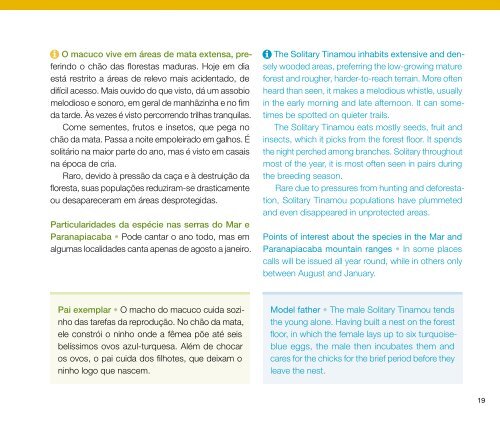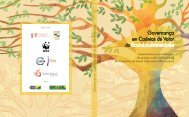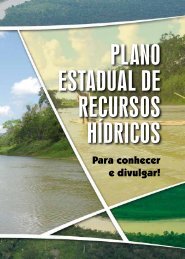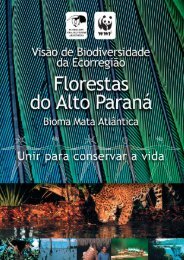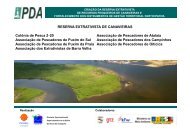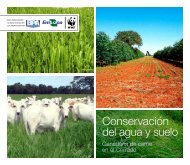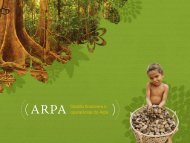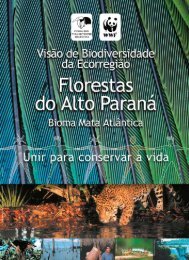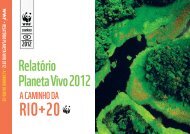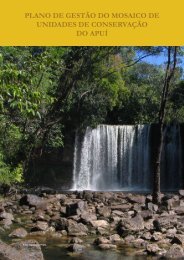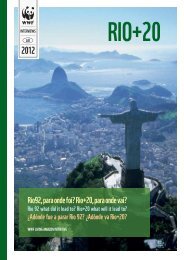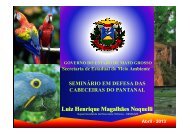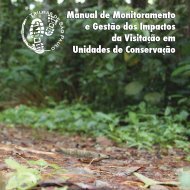Guia de aves Mata Atlântica Paulista
Guia de aves Mata Atlântica Paulista
Guia de aves Mata Atlântica Paulista
Create successful ePaper yourself
Turn your PDF publications into a flip-book with our unique Google optimized e-Paper software.
O macuco vive em áreas <strong>de</strong> mata extensa, preferindo<br />
o chão das florestas maduras. Hoje em dia<br />
está restrito a áreas <strong>de</strong> relevo mais aci<strong>de</strong>ntado, <strong>de</strong><br />
difícil acesso. Mais ouvido do que visto, dá um assobio<br />
melodioso e sonoro, em geral <strong>de</strong> manhãzinha e no fim<br />
da tar<strong>de</strong>. Às vezes é visto percorrendo trilhas tranquilas.<br />
Come sementes, frutos e insetos, que pega no<br />
chão da mata. Passa a noite empoleirado em galhos. É<br />
solitário na maior parte do ano, mas é visto em casais<br />
na época <strong>de</strong> cria.<br />
Raro, <strong>de</strong>vido à pressão da caça e à <strong>de</strong>struição da<br />
floresta, suas populações reduziram-se drasticamente<br />
ou <strong>de</strong>sapareceram em áreas <strong>de</strong>sprotegidas.<br />
Particularida<strong>de</strong>s da espécie nas serras do Mar e<br />
Pa ra napiacaba • Po<strong>de</strong> cantar o ano todo, mas em<br />
algumas localida<strong>de</strong>s canta apenas <strong>de</strong> agosto a janeiro.<br />
The Solitary Tinamou inhabits extensive and <strong>de</strong>nsely<br />
woo<strong>de</strong>d areas, preferring the low-growing mature<br />
forest and rougher, har<strong>de</strong>r-to-reach terrain. More often<br />
heard than seen, it makes a melodious whistle, usually<br />
in the early morning and late afternoon. It can sometimes<br />
be spotted on quieter trails.<br />
The Solitary Tinamou eats mostly seeds, fruit and<br />
insects, which it picks from the forest floor. It spends<br />
the night perched among branches. Solitary throughout<br />
most of the year, it is most often seen in pairs during<br />
the breeding season.<br />
Rare due to pressures from hunting and <strong>de</strong>forestation,<br />
Solitary Tinamou populations have plummeted<br />
and even disappeared in unprotected areas.<br />
Points of interest about the species in the Mar and<br />
Paranapiacaba mountain ranges • In some places<br />
calls will be issued all year round, while in others only<br />
between August and January.<br />
Pai exemplar • O macho do macuco cuida sozinho<br />
das tarefas da reprodução. No chão da mata,<br />
ele constrói o ninho on<strong>de</strong> a fêmea põe até seis<br />
belíssimos ovos azul-turquesa. Além <strong>de</strong> chocar<br />
os ovos, o pai cuida dos filhotes, que <strong>de</strong>ixam o<br />
ninho logo que nascem.<br />
Mo<strong>de</strong>l father • The male Solitary Tinamou tends<br />
the young alone. Having built a nest on the forest<br />
floor, in which the female lays up to six turquoiseblue<br />
eggs, the male then incubates them and<br />
cares for the chicks for the brief period before they<br />
leave the nest.<br />
19


